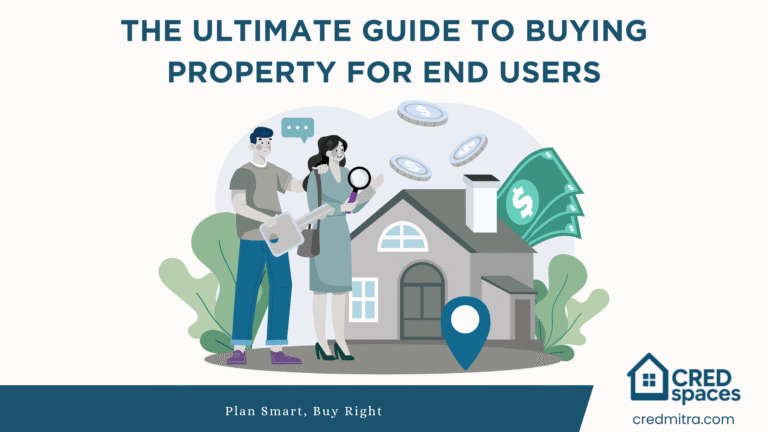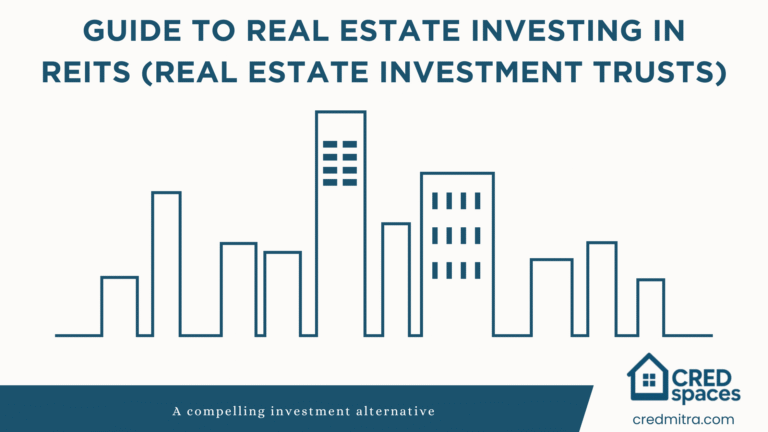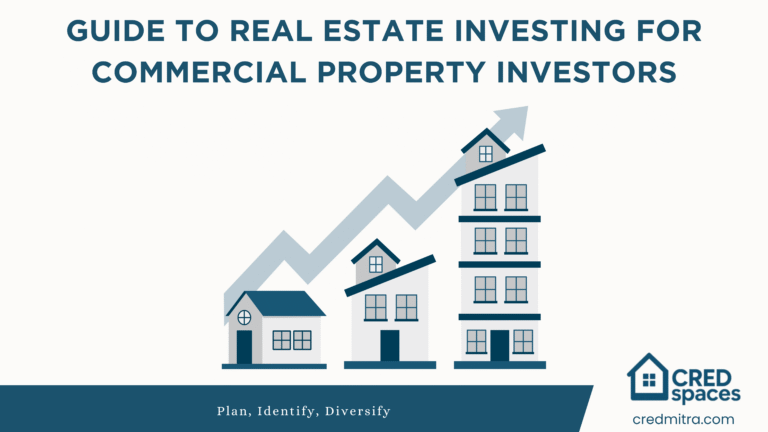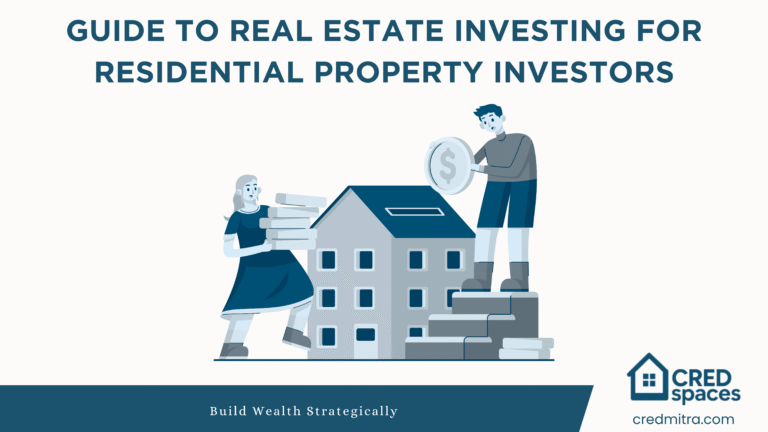Plan, Identify & Diversify
Guide to Real Estate Investing for Commercial Property Investors
- July 9, 2025
- Samved Bharadwaj
- 9:00 am
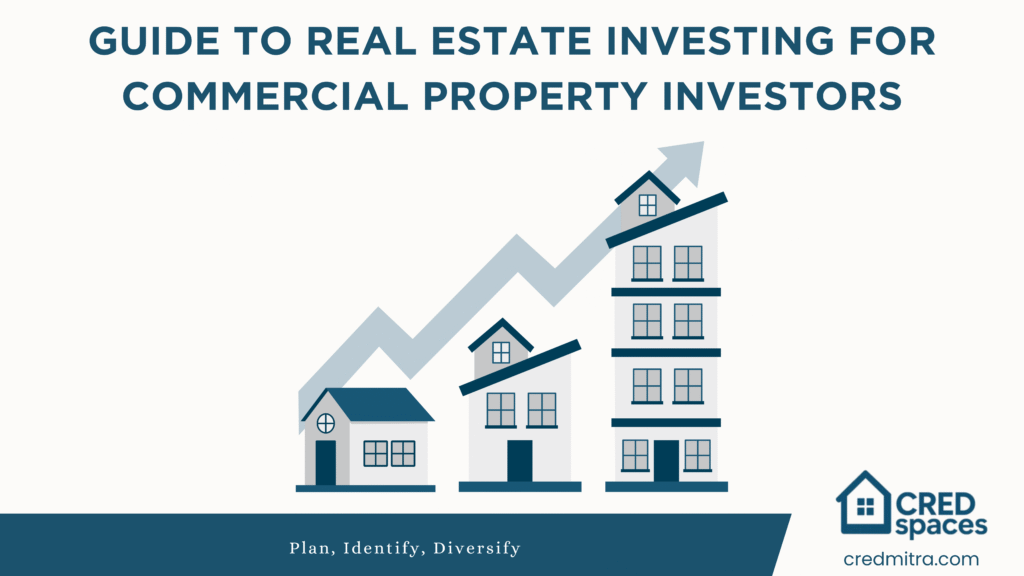
Introduction
Commercial real estate (CRE) investment has long been a favoured avenue for investors seeking robust cash flow, long-term appreciation, and portfolio diversification.
From office spaces and retail outlets to warehouses and co-working hubs, commercial properties offer significantly higher income potential compared to residential real estate — but they also come with a steeper learning curve and larger capital commitment.
As India’s economy expands and urban centres witness rapid infrastructure growth, commercial property investing has become a viable and lucrative choice for both institutional and individual investors.
But how do you make smart investment decisions in such a complex and capital-intensive space?
This in-depth guide is designed to walk you through everything you need to know as a commercial real estate investor — from evaluating opportunities to mitigating risk and maximizing returns.
Why Invest in Commercial Real Estate?
- Higher Rental Yields: Commercial assets typically offer rental yields of 6-10%, significantly higher than residential properties (3-5%). Lease terms are often longer, providing consistent cash flow.
- Professional Tenants: Tenants in commercial spaces are usually businesses, which leads to fewer defaults, better property maintenance, and more structured lease agreements.
- Capital Appreciation: Grade-A commercial properties in business districts or emerging corridors can see strong capital gains over a 5-10 year horizon, especially in high-growth cities.
- Triple Net Leases: In many commercial lease models, tenants bear property taxes, insurance, and maintenance, reducing the landlord’s operating cost burden.
- Diversification: Commercial investments diversify your real estate exposure beyond residential markets, balancing out cyclical risks.
Types of Commercial Real Estate Investments
- Office Spaces: These range from IT parks and standalone buildings to coworking hubs. Demand is driven by employment, outsourcing, and startup ecosystems.
- Retail Stores and Malls: High-street retail, showroom spaces, and shopping complexes serve brands, restaurants, and lifestyle businesses. Location is crucial.
- Warehousing and Industrial Units: A booming segment due to e-commerce growth and supply chain expansion. Lower maintenance, but requires specialized location analysis.
- Co-Working & Flex Spaces: Gaining popularity among freelancers and SMEs, especially post-COVID. These spaces offer shorter leases but higher per sq.ft returns.
- Mixed-Use Developments: A blend of residential, retail, and commercial units in one integrated ecosystem. They offer tenant synergies but require strategic planning.
- REITs (Real Estate Investment Trusts): Publicly traded investment vehicles that allow exposure to commercial real estate without direct ownership. Ideal for passive investors.
How to Identify a Good Commercial Investment
- Location & Demand Fundamentals
- Is the property located in a business or transit hub?
- Are there Fortune 500 companies, banks, or government tenants nearby?
- What’s the vacancy rate in the micro-market?
- Quality of Construction and Layout: Grade-A buildings fetch higher rents and better tenants. Ensure that floorplates are efficient, elevators and amenities are up to commercial standards.
- Tenant Mix & Lease Terms
- Prefer properties with anchor tenants on long leases
- Check for lock-in periods, rent escalation clauses (typically 5% annually or 15% every 3 years), and renewal options
- Rental Yield and Cash Flow Projections: Use this formula:
Rental Yield (%) = (Annual Rent / Total Investment Cost) x 100
For commercial spaces, yields above 6% are desirable.
- Title and Legal Due Diligence
- Ensure property has clear title
- Verify commercial land use approvals
- Check for litigation, building completion certificates, and RERA registration (if applicable)
- Exit Potential: Can the asset be sold easily in the future? Is there demand from other investors or REITs in that area?
Investment Models in Commercial Real Estate
- Outright Purchase: Full ownership of a commercial unit. High capital requirement but maximum control.
- Fractional Ownership: Invest in a share of a high-value property through a tech platform. Diversified exposure, moderate ticket size, shared decision-making.
- Lease Rental Discounting (LRD): Borrow against the rental income of a leased asset. Useful for refinancing or cash flow management.
- Pre-Leased Properties: Buy properties that are already rented out. Lower risk, immediate income.
Financing Commercial Property Investments
- Loan Eligibility & Structure: Unlike residential loans, commercial property loans:
- Have higher interest rates (usually 9-12%)
- Lower LTV ratios (60-75%)
- Require more documentation and credit checks
Use AI-backed platforms like Dhano to assess eligibility, compare offers, and speed up approvals.
- Down Payment Planning: You’ll typically need 25-40% upfront, plus registration and professional fees. Plan liquidity carefully.
- Tax Planning
- Rental income is taxed as business income
- You can claim depreciation and maintenance as expenses
- Interest on loans can be deducted from taxable income
Consult a tax advisor to optimise your structure.
Legal and Compliance Essentials
- Zoning Approval: Property must be in a designated commercial or mix-use zone
- Occupancy Certificate: Confirms legal readiness for use
- Fire Safety & Environmental Clearances: Mandatory for large spaces
- Encumbrance Certificate: Proof of no legal dues
RERA (if under construction): Mandatory disclosures on timelines, usage, and compliance
Technology as an Enabler
Use platforms like CREDmitra for:
- Data-driven asset scoring and return forecasts
- Portfolio management
Common Risks and How to Mitigate Them
Risk | Solution |
Long vacancy periods | Choose prime locations, flexible lease terms |
Market volatility | Diversify across geographies and tenant types |
Regulatory changes | Stay updated on zoning, taxation, and compliance laws |
Legal disputes | Thorough title checks and builder credibility assessment |
Overleveraging | Maintain DSCR (Debt-Service Coverage Ratio) above 1.2 |
Exit Strategy: When & How to Cash Out
- REIT Sale: Transfer your leased property into a REIT pool (if eligible)
- Secondary Market: Sell to another investor via broker or platform
- Buyback or Lease Transfer: Some co-working companies offer buybacks or rent continuity
- Asset Flip: Sell at capital appreciation peak post infrastructure upgrades
Holding period of 3+ years qualifies for Long Term Capital Gains (LTCG) tax with indexation.
Quick Checklist for First-Time Investors in Commercial Property
- Define investment goal: Rental income vs appreciation vs diversification
- Set budget including loan EMI, down payment, and maintenance costs
- Choose the right segment: Office, retail, warehouse, co-working
- Verify all legal documents: Title deed, OC, zoning, RERA (if applicable)
- Do yield calculation and compare with area benchmarks
- Review lease terms: Lock-in, escalation, maintenance, tenant profile
- Check builder reputation and past commercial delivery record
- Use platforms like CREDmitra for identifying property, ROI prediction and portfolio management
- Avoid emotional decisions; follow data-backed insights and due diligence
Plan your exit: Flip, lease income, or REIT alignment
Conclusion
Commercial real estate investing can be one of the most rewarding decisions in your portfolio — if done right. With higher entry barriers come stronger rewards.
By taking a structured approach, leveraging data, and using digital tools for decision-making and compliance, you can avoid common pitfalls and build long-term wealth.
At CREDmitra, we simplify this journey. From discovery and financial analysis to loan facilitation and post-sale asset tracking, our platform CREDmitra empowers commercial real estate investors with everything they need to succeed.
Ready to make your first (or next) commercial investment? Get started with the right tools and expert guidance at CREDmitra today.
Disclaimer
The information provided in this blog is for general informational purposes only and should not be construed as professional financial, investment, or legal advice. While every effort has been made to ensure accuracy, real estate markets are dynamic and influenced by local factors. Readers are encouraged to conduct their own research or consult qualified professionals before making decisions.
Portions of this blog have been enhanced using AI tools to improve readability and data presentation.
